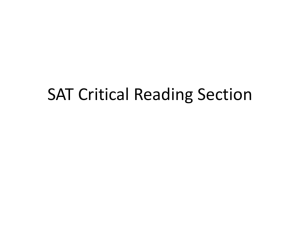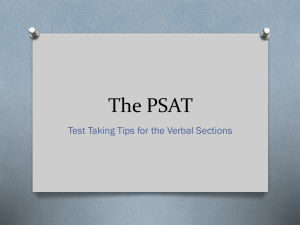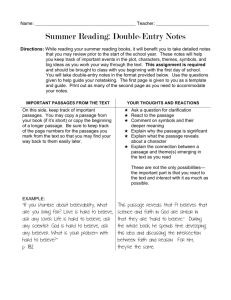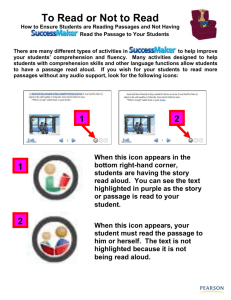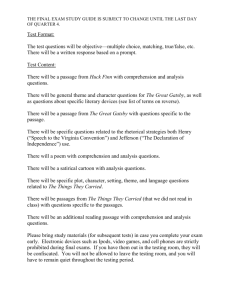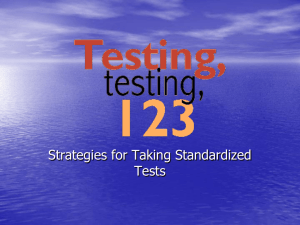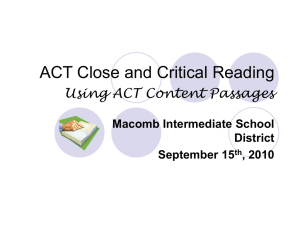PSAT/SAT Workshop
advertisement
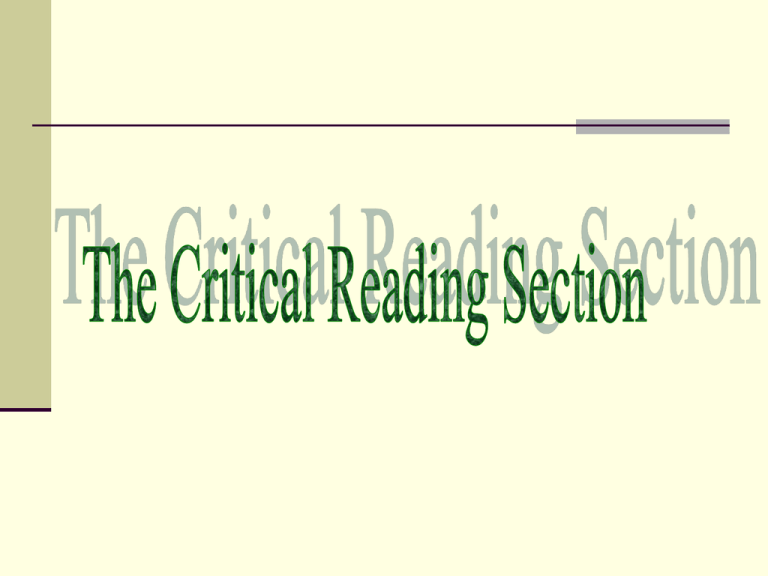
Two Types of Critical Reading Questions: Sentence Completion – 19 multiple choice questions that test your vocabulary and your ability to understand fairly complex sentences. Passage-based reading – 48 questions based on passages ranging from 100 to 850 words. Approaches to Critical Reading Section in General: Work on sentence completion questions first. They require less time to complete. Know your speed. Mark your test booklet. Remember order of difficulty increases in sentence completion as you move through a set. Use process of elimination. Consider related words, familiar phrases, roots, prefixes and suffixes to decode strange words. Approaches to Critical Reading Section in General: Know the directions. Mark skipped questions on answer key and booklet. X vs. ? Sentence Completion Test ability to read carefully and think logically. Test knowledge of college-level vocabulary. The content will be politically correct. Example Today’s small, portable computers contrast markedly with the earliest electronic computers, which were -----. (A) (B) (C) (D) (E) effective invented useful destructive enormous Approaches for Sentence Completion: Read the sentence carefully, substituting the word blank for the blank(s). Keep in mind that introductory and transitional words are very important. Put your own word(s) in the sentence before you look at the answer choices. Compare your word(s) to the answer choices. Scan all the choices. Read the sentence with your selection. Be Aware! Some of the most difficult sentence completion questions contain negatives, which can make it difficult to follow the logic of the sentences. Following this reasoning: The first few questions in a subsection are always easyobvious or most tempting answer. Middle questions- the most obvious answer is sometimes right, sometimes wrong. The last questions- the most obvious answer is probably wrong. What about two-blank questions? Work on one blank at a time. Try to fill in the blank with your own word. Eliminate words that don’t make sense. Sense whether the words are negative or positive, good or bad, compare or contrast. Move to second blank and only look at the remaining options. Always read the sentence with both words in place to make sure your choice makes sense. Two-blank Question Example Hoping to ----- the dispute, negotiators proposed a compromise that they felt would be ------ to both labor and management. (A) enforce .. useful (B) end .. divisive (C) overcome .. unattractive (D) extend .. satisfactory (E) resolve .. acceptable Remember! The instructions for all sentence completion ask you to choose the best answer. There can only be one correct answer. Plug in your best choices- if it fits, go with it. What about tough words? Look in the sentence for clues to the word’s meaning. Where have you heard the word before? Look for familiar roots or prefixes. If all else fails… eliminate choices you think are wrong and guess. Building your Vocabulary Mnemonic devices Flash cards iPods Reading novels, magazines, newspapers The New York Times Time Newsweek National Geographic The New Yorker Sports Illustrated See suggested reading list Passage-based Reading Passages are about 100 to 850 words long. Some selections are from a single source and others consist of a pair of related passages. Topics cover subjects in humanities, social studies, natural sciences, and literary fiction. A set of questions follows each passage or pair of passages. Approaches to Reading the Passages: Skim the questions before reading to get an idea of what to look for when reading. Mark the passages or make short notes. Mark a specific line in the text if it is the focus of a question or main idea. Circle anything that is an answer to one of the questions. Don’t go immediately back to the questions. It will break your concentration and comprehension. Use process of elimination. Approaches to Reading the Passages: Try to summarize the paragraph in your head, jot down notes and paraphrases in the margin. Use your knowledge and experience carefully. If you have to skip a reading passage, skip the last one. Don’t choose an answer because it sounds right, make sure you have evidence to support your answer. Question Types Vocabulary-in-context Tests your ability to understand words and find appropriate synonyms based on sentence context. Literal Comprehension Tests your ability to find specific information that is directly stated in the passage. Extended Reasoning Facts, assumptions, and inferences Logic, style and tone Six Question Types Type 1: General (Main Idea) The author is primarily concerned with… Which of the following titles best summarizes the passage? Type 2: Explicit (Facts) According to the fourth paragraph… Six Question Types Type 3: Implicit (reading between the lines) Asks you to draw conclusions or evaluate the information It can be inferred… With which of the following statements would the author most likely agree? Six Question Types Type 4: Author’s Logic Pretend you’re the author. What tone does the author take toward the children? Which of the following best describes the development of the passage? Six Question Types Type 5: Vocabulary-in-context How is the word used in the passage? The most common definition may not be the correct answer ALWAYS look back. The word obtrusive is used in line 12… The phrase “underlying theme” refers to… Six Question Types Type 6: Comparison-Paired Passages Read the introduction. Read the first passage, and do the questions about it. Read the second passage, and do the questions that relate to it. Do the questions about the relationship between the two passages. Approaches to Passage-based questions: Keep in mind, the answers come from the passages. Remember every word counts. Read the questions and answer carefully. Don’t forget that an answer choice can be both true and wrong. Make sure the reading passage supports your answer. Try eliminating choices. Double check other choices. Don’t jump from passage to passage. Approaches to Passage-based questions: Read directions carefully, look for italics, often they will define words or identify names. Don’t let scientific jargon intimidate you. You do not need to have outside knowledge . All of the important information will be in the passages. Questions are presented in order that the answers appear in the text. If they specify a line then the answer will be in that line. Avoiding Anxiety Pitfalls Before the test: Don’t cram. Do something enjoyable and relaxing. Get a good night’s sleep. Have everything ready the night before. Know the way to the test center. Leave time for mishaps and emergencies. Pitfalls continued Think Positively! Use affirmative statements! Encourage yourself! During the Test: Keep yourself focused. Concentrate on yourself. Stay physically relaxed. MOST IMPORTANT! Keep the test in perspective!!
